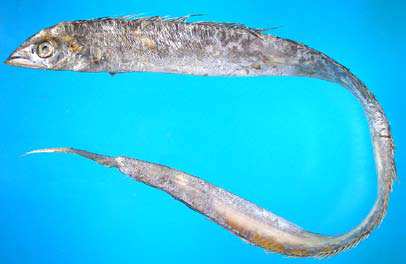TRICHIURIDAE
Cutlassfishes
By Yukio Iwatsuki
 Tentoriceps cristatus |
 Trichiurus lepturus |
|
Body extremely elongate and compressed, ribbon-like (up to 2.5 m). Mouth large, not protracticle; strong canine teeth in jaws, those at front of upper jaw fang-like; minute teeth on palatines, none on vomer. Single nostril on each side of head. Small spinescent gill rakers present. Dorsal fin low and long, beginning shortly behind eye, anterior part with spines and posterior part with soft rays, spinnules part shorter than soft part. Pelvic fins reduced to a scale-like spine in Tentoriceps or completely absent in Trichiurus. Anal fin low, or reduced to embedded short spinnules. Caudal fin small and forked or absent like tapering to a point. Lateral line single. Scales absent. Color: body generally metallic silvery with blue tint, darker dorsally; pectoral fin semi transparent; dorsal and anal fins sometimes tinged with pale yellow. Usually no distinct marks or blotches on body. Voracious predators distributed in tropical and temperate seas of all oceans. generally inhabit deeper waters of continental shelf and slope. Trichiurus important local fisheries, especially in the southeast Asia. Flesh tasty, but scanty in Trichiurus. Similar families occurring in the area. Gempylidae: double nostrils on each side of head; 2 dorsal fins. Remarks. Benthopelagic fishes, usually found on continental shelves and slopes. Feeding on fishes, squid and crustaceans. |

|
|